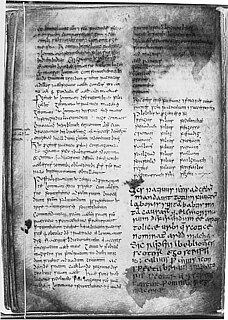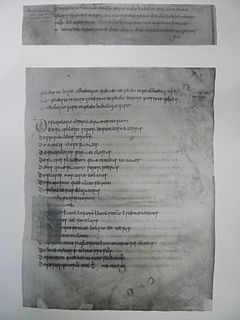 W
WThe Annales Almannici, which are also referred to as the Annals of St. Gall, provide one of the earliest records of Medieval Europe available. The core text of the Annales Alamannici covers the years 709 through to 799. Spread over several Swabian monasteries, the annals were continued independently in several places, in the Reichenau Abbey up to 939, in Abbey of Saint Gall up to 926. The St. Gallen version was continued from 927 to 1059 as the Annales Sangallenses maiores. They depict a limited number of events, in short prose, but their value to scholars is in their medieval representational style.
 W
WThe Annales Fuldenses or Annals of Fulda are East Frankish chronicles that cover independently the period from the last years of Louis the Pious to shortly after the end of effective Carolingian rule in East Francia with the accession of the child-king, Louis III, in 900. Throughout this period they are a near contemporary record of the events they describe and a primary source for Carolingian historiography. They are usually read as a counterpart to the narrative found in the West Frankish Annales Bertiniani.
 W
WAnnales Laurissenses minores or ALM is the Latin name of a medieval, historiographic text from the abbey at Lorsch near Worms in Germany. In many German texts, they are also called the Kleine Lorscher Frankenchronik, but in English may be referred to as the "Short chronicle of Lorsch" or "Lesser Annals of Lorsch".
 W
WThe Annales Xantenses or Annals of Xanten are a series of annals written, probably at Lorsch for the period 832 to 852 and at Cologne for the period until 873. The Lorsch author is probably Gerward, a royal chaplain, but the continuator is unknown. For that period (832–873) they present an independent source to augment the other Reichsannalen.
 W
WThe epithet "Bavarian Geographer" is the conventional name for the anonymous author of a short Latin medieval text containing a list of the tribes in Central-Eastern Europe, headed Descriptio civitatum et regionum ad septentrionalem plagam Danubii.
 W
WThe Book of Armagh or Codex Ardmachanus, also known as the Canon of Patrick and the Liber Ar(d)machanus, is a 9th-century Irish illuminated manuscript written mainly in Latin. It is held by the Library of Trinity College Dublin. The document is valuable for containing early texts relating to St Patrick and some of the oldest surviving specimens of Old Irish, and for being one of the earliest manuscripts produced by an insular church to contain a near complete copy of the New Testament.
 W
WThe Book of Kells is an illuminated manuscript Gospel book in Latin, containing the four Gospels of the New Testament together with various prefatory texts and tables. It was created in a Columban monastery in either Britain or Ireland and may have had contributions from various Columban institutions from both Britain and Ireland. It is believed to have been created c. 800 AD. The text of the Gospels is largely drawn from the Vulgate, although it also includes several passages drawn from the earlier versions of the Bible known as the Vetus Latina. It is a masterwork of Western calligraphy and represents the pinnacle of Insular illumination. It is also widely regarded as one of Ireland's finest national treasures. The manuscript takes its name from the Abbey of Kells, which was its home for centuries.
 W
WBritish Library, Add MS 11848 is an illuminated Carolingian Latin Gospel Book produced at Tours. It contains the Vulgate translation of the four Gospels written on vellum in Carolingian minuscule with Square and Rustic Capitals and Uncials as display scripts. The manuscript has 219 extant folios which measure approximately 330 by 230 mm. The text is written in area of about 205 by 127 mm. In addition to the text of the Gospels, the manuscript contains the letter of St. Jerome to Pope Damasus and of Eusebius of Caesarea to Carpian, along with the Eusebian canon tables. There are prologues and capitula lists before each Gospel. A table of readings for the year was added, probably between 1675 and 1749, to the end of the volume. This is followed by a list of capitula incipits and a word grid which were added in the Carolingian period.
 W
WThe Codex Millenarius is an ancient book, containing all four Gospels in Latin. Believed to have been written around 800 at Mondsee Abbey, it is housed in the great library of Kremsmünster Abbey in Austria, which contains other items of paramount religious and cultural value, such as the Tassilo Chalice.
 W
WThe Collectio canonum quadripartita is an early medieval canon law collection, written around the year 850 in the ecclesiastical province of Reims. It consists of four books. The Quadripartita is an episcopal manual of canon and penitential law. It was a popular source for knowledge of penitential and canon law in France, England and Italy in the ninth and tenth centuries, notably influencing Regino's enormously important Libri duo de synodalibus causis. Even well into the thirteenth century the Quadripartita was being copied by scribes and quoted by canonists who were compiling their own collections of canon law.
 W
WDe divisione naturae is the title given by Thomas Gale to his edition (1681) of the work originally titled by 9th century theologian Johannes Scotus Eriugena Periphyseon.
 W
WThe Drogo Sacramentary is a Carolingian illuminated manuscript on vellum from c. 850 AD, one of the monuments of Carolingian book illumination. It is a sacramentary, a book containing all the prayers spoken by the officiating priest during the course of the year.
 W
WThe so-called Aachen Compilation of 809–812, also called the Handbook of 809 is a Carolingian astronomical compendium, compiled by a group of astronomers who gathered at the court of Charlemagne at Aachen in the year 809.
 W
WThe Indiculus superstitionum et paganiarum is a Latin collection of capitularies identifying and condemning superstitious and pagan beliefs found in the north of Gaul and among the Saxons during the time of their subjugation and conversion by Charlemagne.
 W
WKarolus magnus et Leo papa, sometimes called the Paderborn Epic or the Aachen Epic, is a Carolingian Latin epic poem of which only the third of four books is extant. It recounts the meeting of Charlemagne, king of the Franks, with Pope Leo III, in AD 799.
 W
WLeiden, Universiteitsbibliotheek, VLQ 79, also called the Leiden Aratea, is an illuminated copy of an astronomical treatise by Germanicus, based on the Phaenomena of Aratus. The manuscript was created in the region of Lorraine and has been dated to around 816. It was produced at the court of Louis the Pious, who ruled from 814–840. It is one of the four Carolingian codices that were produced in his court. There are many translations and copies of this text, so it is very well known throughout the Middle East and Europe.
 W
WThe Liber de apparitione Sancti Michaelis in Monte Gargano is a composite 9th century hagiographical text by an anonymous author containing the foundation myth of the Sanctuary of Monte Sant'Angelo, also known as Mont Gargano, on Mount Gargano, Italy, in northern Apulia. It contains record of the first known appearance of Saint Michael the Archangel in western Europe after the transmission of his cult from the Greek East.
 W
WThe Murbach hymns are a collection of 27 early medieval Latin hymns with interlinear Old High German translation. The hymns are intended to be sung at certain times of the day in the course of the year, being introduced with the header Incipiunt hymni canendae per cirulum anni.
 W
WVita Hludovici or Vita Hludovici Imperatoris is an anonymous biography of Louis the Pious, Holy Roman Emperor and King of the Franks from AD 814 to 840.
 W
WVita Karoli Magni is a biography of Charlemagne, King of the Franks and Holy Roman Emperor, written by Einhard.